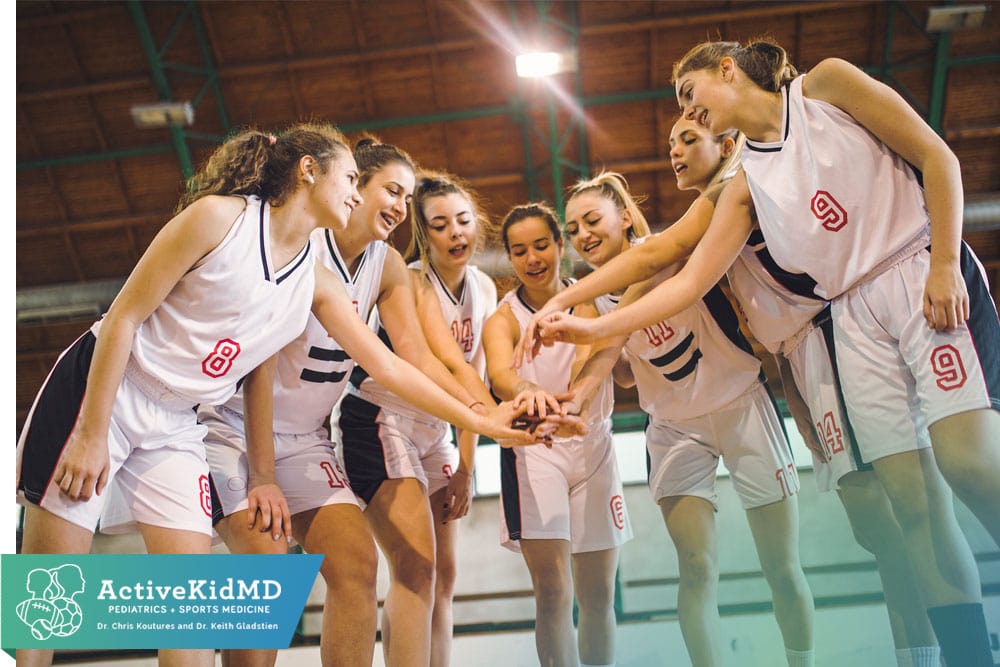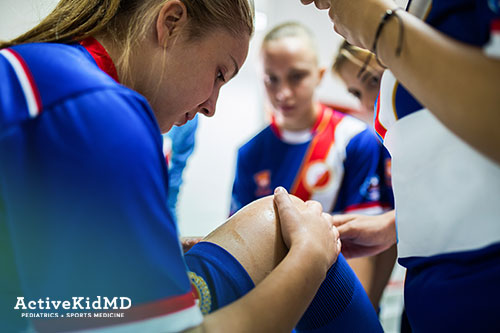After spending time away from organized activities, there will be an understood eagerness to quickly return to previous levels of practice and competition. That being said, it is best to protect young athletes and performers by realizing that starting with too many or too intense practices can be a recipe for bone and soft tissue overload injuries that will quickly put athletes right back out of play for long periods of time.
Coaches and parents can best serve their young athletes by promoting gradual returns to activity rather than rushing and pushing kids back to “where we were.” No online workout, individual training session, or home workout can match the speed, timing, and conditioning demands of sport-specific activities. It is best to expect that all returning participants will be at some level of deconditioning – some more than others.
Overload and overuse injuries come from either too much acute stress on normal bones, joints and muscles, or normal stresses on weaker bones, joints and muscles. Athletes who have been inactive for a longer period of time and immediately amp up activity may suffer from both conditions.
In general, this process may take several weeks. Remember, we get in shape to play sports, not play sports to get in shape.
A sensible recovery and rebuilding preparation plan includes:
Starting with a review of individual skills and techniques. Not only are athletes deconditioned, but some of them might actually have grown over the past several months. Growth periods and time away from activity are big contributors to young athletes losing technique skills. Go back to basics. Start with simple drills that would have been performed years ago.
- Review jumping, landing and cutting movements. The issue with this is parents, coaches and players often times are unfamiliar with the most effective techniques. In this case, it may be best to utilize a professional who understands and can teach these mechanics.
CLICK HERE FOR LINK: Use these 2 exercises to help prevent ACL injuries
- Keeping initial practices shorter. Young athletes will fatigue quicker, and fatigued athletes get injured.
- Limiting repeats of repetitive movements like volleyball hitting reps, throwing, swinging, or leaping/jumping.
- Planning for at least one day off between practices. There is no logical role for double day or back-to-back daily sessions. Bones and muscles need time for repair. Coaches and parents need to plan accordingly since club practices are typically 2-4 days a week, and many athletes also add in private lessons. The athletes’ body needs more time to recover in these important first few weeks.
- Looking at the mental game. Some young athletes may not want to quickly come back or at all. Give kids a voice to play an active role in deciding when and how fast they return.
As players return to their sport, parents and athletes may want to consider engaging a professional to help get back into game shape, improve strength and reduce the risk of injury.
Now, even in the most thoughtful and well-intentioned situations, young athletes are going to have pain and soreness as they resume activities. Some of this might be “normal and anticipated” while some may not.
When should a parent, athlete or coach get more worried?
- If there is finger-tip pain.
- If you can use the tip of your finger to point out a location of pain, there is a higher chance for a significant bone injury, ligament sprain or muscle tear/strain.
CLICK HERE FOR LINK: Bone Stress Injuries
- If you can use the tip of your finger to point out a location of pain, there is a higher chance for a significant bone injury, ligament sprain or muscle tear/strain.
- If there is any lack of joint motion, especially in school-aged athletes.
- For example, a thrower being unable to fully straighten an elbow can be a sign of damage to growth plates or within a joint.
- If there is a sudden onset of pain and limited motion after throwing, landing, or changing direction. Hearing or feeling a pop sensation is even more worrisome.
- If there is any limping or change in walking or running technique.
- If the athlete is constantly thinking about an uncomfortable body part (i.e. having to limit cutting or turning since my foot hurts).
If there is obvious bruising or joint swelling.
- When there is a need for medication (Ibuprofen, Naprosyn, Acetaminophen or similar products) either right before or after practice.
- When there is soreness or pain during or after exercise.
- In this case, ask athletes to rate soreness and pain on a 0-10 scale
- 0-3 during and right after practice is one thing, any score 4 or higher is a more of a concern
- Soreness and pain should be gone by the next morning.
- In this case, ask athletes to rate soreness and pain on a 0-10 scale
- When there is any pain or soreness while at rest. For example, when:
- Being awakened at night leading to poor sleep
- Just sitting, resting, or lying down watching Netflix
- When the same pain does not go away after 2-3 days
- If the athlete has pain, even muscle soreness, they should avoid going back to practice as it may lead to injury.
There should be no hesitation to have an athlete see a sports medicine specialist such as a Physician, Athletic Trainer or Physical Therapist for any concern. Pushing through pain, soreness, swelling or limited motion may lead to more serious damage and a longer recovery process.
Dr. Chris Koutures is a dual board-certified pediatric and sports medicine specialist who practices at ActiveKidMD in Anaheim Hills, CA. He is a team physician for USA Volleyball (including participating in the 2008 Beijing Olympics), the U.S. Figure Skating Sports Medicine Network, Cal State Fullerton Intercollegiate Athletics, Chapman University Dance Department, and Orange Lutheran High School. He offers a comprehensive blend of general pediatric and sport medicine care with an individualized approach to each patient and family. Please visit https://activekidmd.com/or follow him on Twitter @dockoutures.
Chris Phillips is an Athletic Trainer, Strength and Conditioning Specialist and Sports Safety Specialist with over 25 years’ experience in professional hockey, football, dance, cheerleading, and soccer. Chris has worked with hundreds of professional, Olympic and Hall of Fame dancers and is the owner of Compete Sports Performance and Rehab in Lake Forest, California. For more information, visit http://competesportsperformance.com/ or follow him on Twitter @chriscompete


 Starting with a review of individual skills and techniques. Not only are athletes deconditioned, but some of them might actually have grown over the past several months. Growth periods and time away from activity are big contributors to young athletes losing technique skills. Go back to basics. Start with simple drills that would have been performed years ago.
Starting with a review of individual skills and techniques. Not only are athletes deconditioned, but some of them might actually have grown over the past several months. Growth periods and time away from activity are big contributors to young athletes losing technique skills. Go back to basics. Start with simple drills that would have been performed years ago.
 If there is obvious bruising or joint swelling.
If there is obvious bruising or joint swelling.